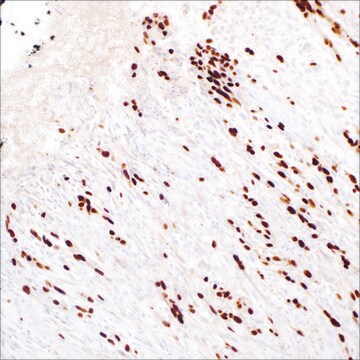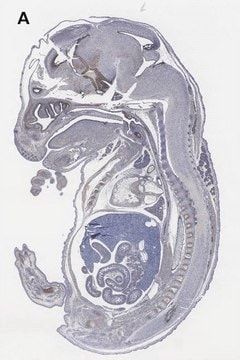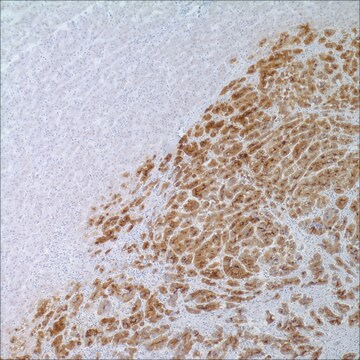推薦產品
生物源
rabbit
品質等級
100
500
共軛
unconjugated
抗體表格
culture supernatant
抗體產品種類
primary antibodies
無性繁殖
SP76, monoclonal
描述
For In Vitro Diagnostic Use in Select Regions (See Chart)
形狀
buffered aqueous solution
物種活性
human
包裝
vial of 0.1 mL concentrate (371R-14)
vial of 0.5 mL concentrate (371R-15)
bottle of 1.0 mL predilute (371R-17)
vial of 1.0 mL concentrate (371R-16)
bottle of 7.0 mL predilute (371R-18)
製造商/商標名
Cell Marque®
技術
immunohistochemistry (formalin-fixed, paraffin-embedded sections): 1:50-1:200
同型
IgG
控制
squamous epithelium
運輸包裝
wet ice
儲存溫度
2-8°C
視覺化
nuclear
基因資訊
human ... SOX2(6657)
一般說明
It has been reported that anti-SOX-2 antibody recognizes lung squamous cell carcinoma (LSCC). A recent study has demonstrated that extensive anti-SOX-2 staining was seen in over 90% of LSCC and largely paralleled p63 expression. Extensive anti-SOX-2 staining was seen in 21% of lung adenocarcinomas (LACA), including cases that were anti-p63-negative or only anti-p63 focally-positive. However, another recent study showed only 4.5% of LACA is positive for anti-SOX-2 expression. In a study by Sholl et al, 29% of LACA cases exhibited at least focal p63 expression. Combined p63 and SOX-2 expression was seen in 94% of LSCC and 12% of LACA with a statistically significant difference (P<0.0001) versus p63 alone. This study also showed that anti-CK5/6 had a good sensitivity but poor specificity for LSCC. Combined anti-CK5/6 and anti-p63 positivity was seen in 93% of LSCC and 24% of LACA. Anti-CK5/6+/anti-p63+/anti- SOX-2+ was detected in 93% of LSCC and only 9% of LACA. These results indicate that the sensitivity of anti-p63 is equally high but its specificity is similarly variable; it was seen at least focally in close to 30% of LACA. When used together, anti-p63+/anti-SOX-2+ applied to the same tumor cell population is >90% specific for LSCC. Anti-SOX-2 produced moderate-to-intense staining in all 50 cases of embryonal carcinoma components. The only other component that showed reactivity was the primitive neuroectodermal component in 11 of 14 (79%) of immature teratomas. In each of these positive staining foci, the staining varied from moderate-to-strong. Yolk sac tumor, seminoma, mature teratoma, choriocarcinoma, and IGCNU were uniformly negative, as were all the non-neoplastic parenchymal and stromal structures.
品質
 IVD |  IVD |  IVD |  RUO |
聯結
SOX-2 Positive Control Slides, Product No. 371S, are available for immunohistochemistry (formalin-fixed, paraffin-embedded sections).
外觀
Solution in Tris Buffer, pH 7.3-7.7, with 1% BSA and <0.1% Sodium Azide
準備報告
Download the IFU specific to your product lot and formatNote: This requires a keycode which can be found on your packaging or product label.
其他說明
For Technical Service please contact: 800-665-7284 or email: service@cellmarque.com
法律資訊
Cell Marque is a registered trademark of Merck KGaA, Darmstadt, Germany
未找到適合的產品?
試用我們的產品選擇工具.
從最近期的版本中選擇一個:
Koji Tsuta et al.
Journal of thoracic oncology : official publication of the International Association for the Study of Lung Cancer, 6(7), 1190-1199 (2011-05-31)
Recent clinical trials revealed that accurate histologic typing of non-small cell lung cancer, especially squamous cell carcinoma (SCC), is essential. We analyzed 10 antibodies expression in 150 SCC cases (53 well-, 51 moderately, and 46 poorly differentiated cases) and 159
Lynette M Sholl et al.
Applied immunohistochemistry & molecular morphology : AIMM, 18(1), 55-61 (2009-08-08)
Sox2 is a transcription factor that regulates embryonic stem cell pluripotency and drives commitment of airway precursor cells to basal-type and neuroendocrine cells in the developing lung. In cancer, Sox2 has been associated with a "stemness" phenotype that predicts for
Anuradha Gopalan et al.
Modern pathology : an official journal of the United States and Canadian Academy of Pathology, Inc, 22(8), 1066-1074 (2009-04-28)
Stem cell markers, OCT3/4, and more recently SOX2 and growth differentiation factor 3 (GDF3), have been reported to be expressed variably in germ cell tumors. We investigated the immunohistochemical expression of these markers in different testicular germ cell tumors, and
我們的科學家團隊在所有研究領域都有豐富的經驗,包括生命科學、材料科學、化學合成、色譜、分析等.
聯絡技術服務








